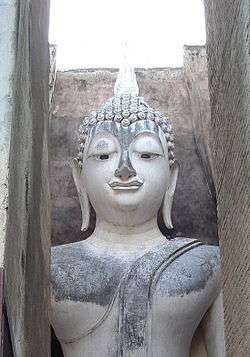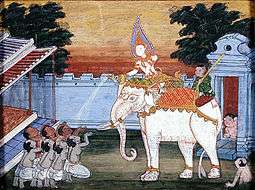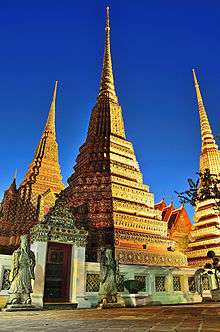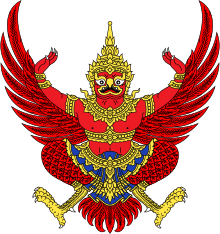Thai art
Traditional Thai art is primarily composed of Buddhist art and scenes from the Indian epics. Traditional Thai sculpture almost exclusively depicts images of the Buddha. Traditional Thai paintings usually consist of book illustrations, and painted ornamentation of buildings such as palaces and temples.
History
Sukhothai period

The Sukhothai period began in the 14th century in the Sukhothai kingdom. Buddha images of the Sukhothai period are elegant, with sinuous bodies and slender, oval faces. This style emphasized the spiritual aspect of the Buddha, by omitting many small anatomical details. The effect was enhanced by the common practice of casting images in metal rather than carving them. This period saw the introduction of the "walking Buddha" pose. Everything has its own purposes.
Sukhothai artists tried to follow the canonical defining marks of a Buddha, as they are set out in ancient Pali texts:
- Skin so smooth that dust cannot stick to it
- Legs like a deer
- Thighs like a banyan tree
- Shoulders as massive as an elephant's head
- Arms round like an elephant's trunk, and long enough to touch the knees
- Hands like lotuses about to bloom
- Fingertips turned back like petals
- head like an egg
- Hair like scorpion stingers
- Chin like a mango stone
- Nose like a parrot's beak
- Earlobes lengthened by the earrings of royalty
- Eyelashes like a cow's
- Eyebrows like drawn bows
Sukhothai also produced a large quantity of glazed ceramics in the Sawankhalok style, which were traded throughout south-east Asia.
Ayutthaya period
The surviving art from this period was primarily executed in stone, characterised by juxtaposed rows of Buddha figures. In the middle period, Sukhothai influence dominated, with large bronze or brick and stucco Buddha images, as well as decorations of gold leaf in free-form designs on a lacquer background. The late period was more elaborate, with Buddha images in royal attire, set on decorative bases.
Bangkok period
This period is characterized by the further development of the Ayutthaya style, rather than by more great innovation. One important element was the Krom Chang Sip Mu (Organization of the Ten Crafts), originally founded in Ayutthaya, which was responsible for improving the skills of the country's craftsmen. Paintings from the mid-19th century show the influence of Western art.
Contemporary
Painting

Traditional Thai paintings showed subjects in two dimensions without perspective. The size of each element in the picture reflected its degree of importance. The primary technique of composition is that of apportioning areas: the main elements are isolated from each other by space transformers. This eliminated the intermediate ground, which would otherwise imply perspective. Perspective was introduced only as a result of Western influence in the mid-19th century. Monk artist Khrua In Khong is well-known as the first artist to introduce linear perspective to Thai traditional art.
The most frequent narrative subjects for paintings were or are: the Jataka stories, episodes from the life of the Buddha, the Buddhist heavens and hells, themes derived from the Thai versions of the Ramayana and Mahabharata, not to mention scenes of daily life. Some of the scenes are influenced by Thai folklore instead of following strict Buddhist iconography.
Architecture

The Major part of the country's cultural legacy and reflects both the challenges of living in Thailand's sometimes extreme climate as well as, historically, the importance of architecture to the Thai people's sense of community and religious beliefs. Influenced by the architectural traditions of many of Thailand's neighbors, it has also developed significant regional variation within its vernacular and religious buildings.
- Thai temple
Buddhist temples in Thailand are known as "wats", from the Pāḷi vāṭa, meaning an enclosure. A temple has an enclosing wall that divides it from the secular world. Wat architecture has seen many changes in Thailand in the course of history. Although there are many differences in layout and style, they all adhere to the same principles.
- Traditional Thai houses
As the phrase "Thai stilt house" suggests, one universal aspect of Thailand's traditional architecture is the elevation of its buildings on stilts, most commonly to around head height. The area beneath the house is used for storage, crafts, lounging in the daytime, and sometimes for livestock. The houses were raised due to heavy flooding during certain parts of the year, and in more ancient times, predators. Thai building and living habits are often based on superstitious and religious beliefs. Many other considerations such as locally available materials, climate, and agriculture have a lot to do with the style.
Ceramics
Ceramics in Thailand were mostly used for domestic purposes such as holding food and water. Thai ceramics in the pattern of nature and animals were popular between the 11th and 13th centuries.
See also
References
Further reading
- Lerner, Martin (1984). The flame and the lotus: Indian and Southeast Asian art from the Kronos collections. New York: The Metropolitan Museum of Art. ISBN 0870993747.
- Piriya Krairiksh (Edited by Peter Sharrock; Translated by Narisa Chakrabongse; Photography Paisarn Piemmettawat) (2012). The Roots of Thai Art. Bangkok: River Books. ISBN 9786167339115.
External links
| Wikimedia Commons has media related to Art of Thailand. |
- Rama IX Art Museum Virtual museum of Thai contemporary artists. Listings of museums, galleries, exhibitions and venues. Contains lots of information on Thai artists and art activities.
- Golden Triangle Art Introduction of contemporary art and artists living and working in Northern Thailand and Myanmar. Guide to art galleries, art News and exhibitions with focus on Chiang Mai.
- Thai Art Gallery
- Thai Buddhist Art Thai Buddhist Art Website Project to Promote and play a part in the growth of the Thai Fine Art Community of Collectors and Aficionados. Representing a host of Thailand's Most Outstanding Artists.

